2007 Lexus GS350 brake light
[x] Cancel search: brake lightPage 182 of 562
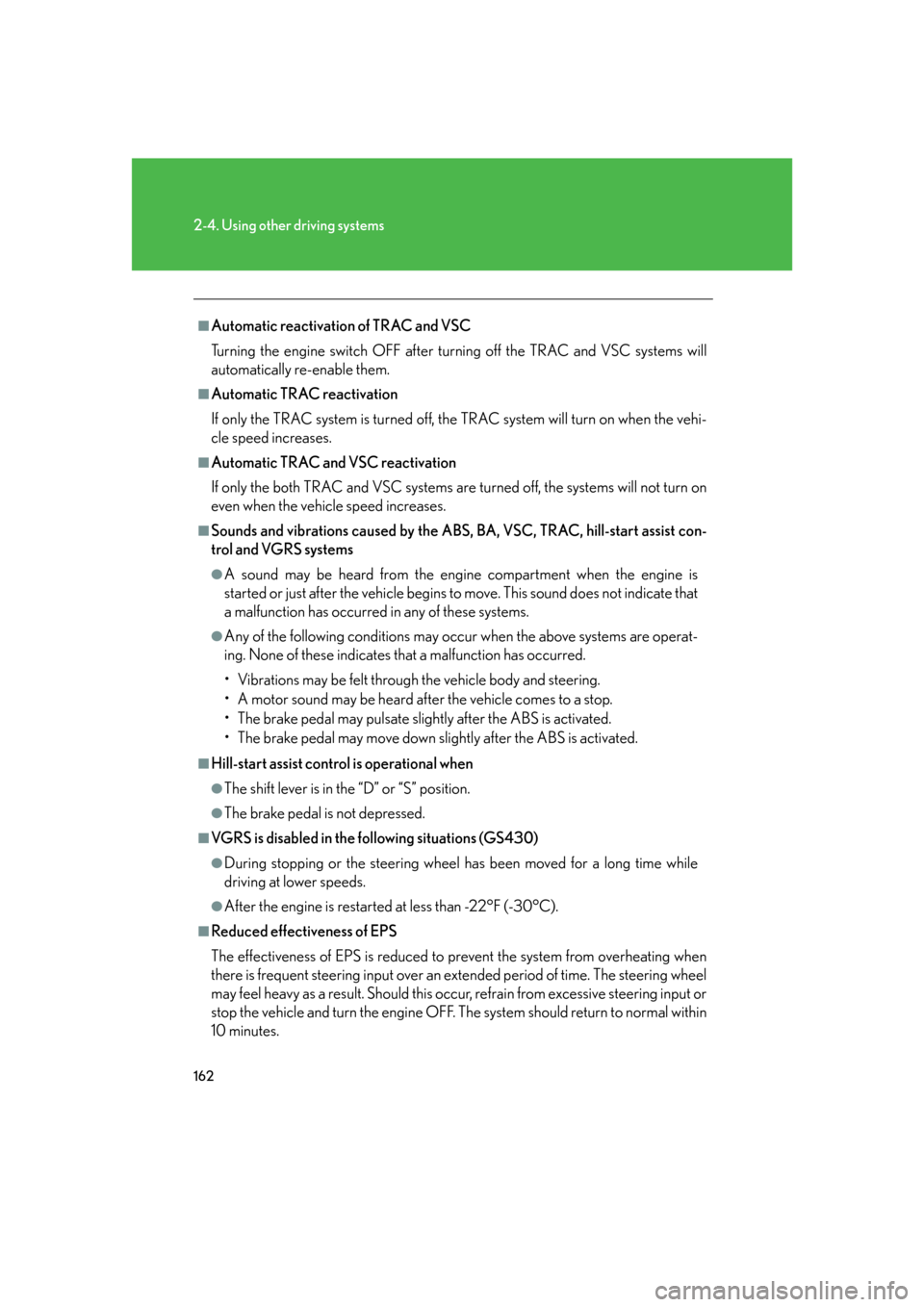
162
2-4. Using other driving systems
■Automatic reactivation of TRAC and VSC
Turning the engine switch OFF after turning of
f the TRAC and VSC systems will
automatically re-enable them.
■Automatic TRAC reactivation
If only the TRAC system is turned off, th e
TRAC system will turn on when the vehi-
cle speed increases.
■Automatic TRAC and VSC reactivation
If only the both TRAC and VSC systems are tur
ned off, the systems will not turn on
even when the vehicle speed increases.
■Sounds and vibrations caused by the ABS, BA, VSC, TRAC, hill-start assist con-
trol and VGRS systems
●A sound may be heard from the engine compartment when the engine is
started or just after the vehicle begins to move. This sound does not indicate that
a malfunction has occurred in any of these systems.
●Any of the following conditions may occur when the above systems are operat -
ing. None of these indicates that a malfunction has occurred.
• Vibrations may be felt through the vehicle body and steering.
• A motor sound may be heard after the vehicle comes to a stop.
• The brake pedal may pulsate slightly after the ABS is activated.
• The brake pedal may move down slightly af
ter the ABS is activated.
■Hill-start assist control is operational when
●The shift lever is in the “D” or “S” position.
●The brake pedal is not depressed.
■VGRS is disabled in the following situations (GS430)
●During stopping or the steering wheel has been moved for a long time while
driving at lower speeds.
●After the engine is restarted at less than -22°F (-30°C).
■Reduced effectiveness of EPS
The effectiveness of EPS is reduced to prevent the system from overheating when
th
ere is frequent steering input over an extended period of time. The steering wheel
may feel heavy as a result. Should this occur, refrain from excessive steering input or
stop the vehicle and turn the engine OFF. Th e system should return to normal within
10 minutes.
Page 186 of 562
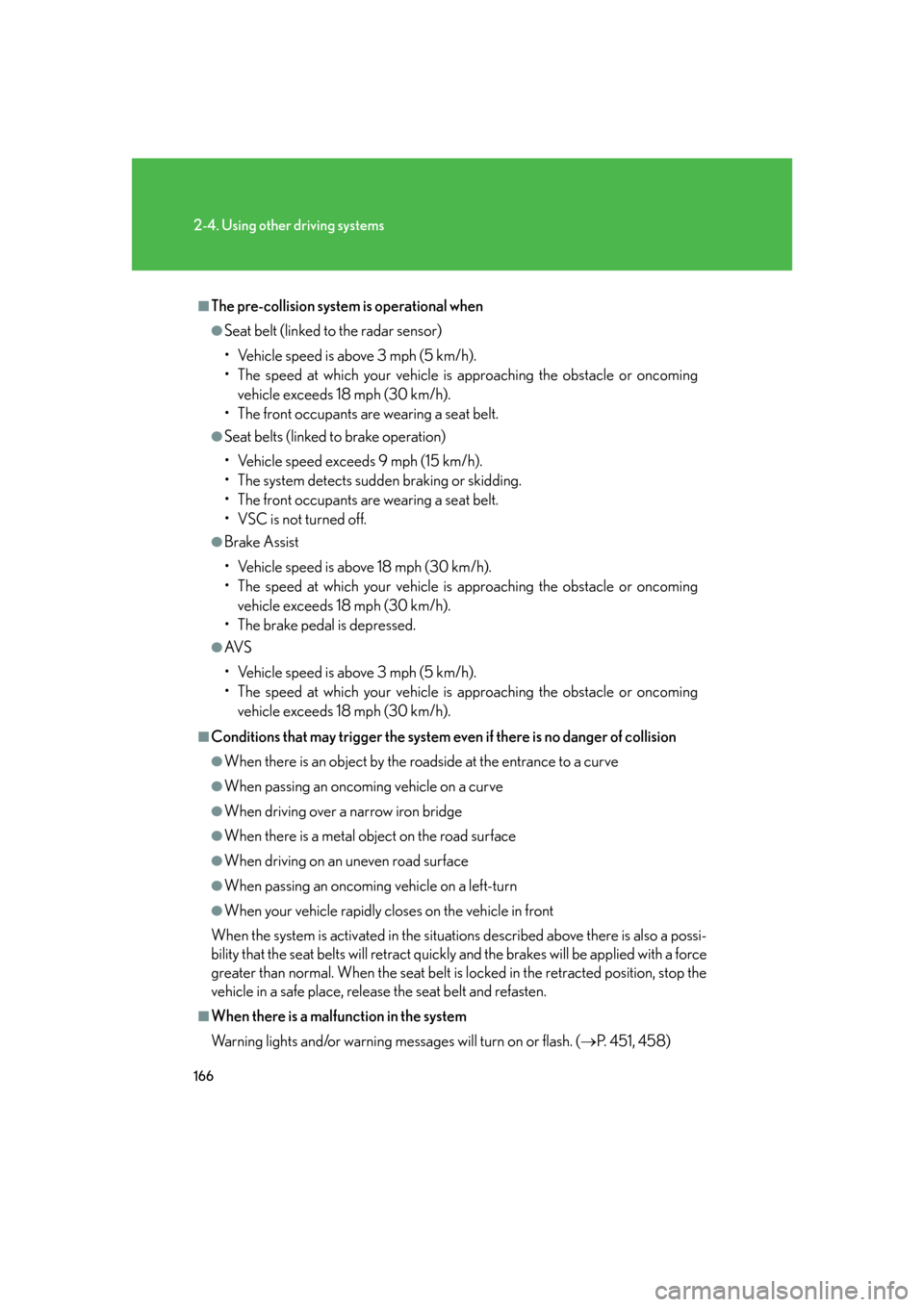
166
2-4. Using other driving systems
■The pre-collision system is operational when
●Seat belt (linked to the radar sensor)
• Vehicle speed is above 3 mph (5 km/h).
• The speed at which your vehicle is approaching the obstacle or oncoming vehicle exceeds 18 mph (30 km/h).
• The front occupants are wearing a seat belt.
●Seat belts (linked to brake operation)
• Vehicle speed exceeds 9 mph (15 km/h).
• The system detects sudd en braking or skidding.
• The front occupants are wearing a seat belt.
•VSC is not turned off.
●Brake Assist
• Vehicle speed is above 18 mph (30 km/h).
• The speed at which your vehicle is approaching the obstacle or oncoming vehicle exceeds 18 mph (30 km/h).
• The brake pedal is depressed.
●AV S
• Vehicle speed is above 3 mph (5 km/h).
• The speed at which your vehicle is approaching the obstacle or oncoming vehicle exceeds 18 mph (30 km/h).
■Conditions that may trigger the system even if there is no danger of collision
●When there is an object by the roadside at the entrance to a curve
●When passing an oncoming vehicle on a curve
●When driving over a narrow iron bridge
●When there is a metal object on the road surface
●When driving on an uneven road surface
●When passing an oncoming vehicle on a left-turn
●When your vehicle rapidly closes on the vehicle in front
When the system is activated in the situations described above there is also a possi-
bility that the seat belts will retract quickly and the brakes will be applied with a force
greater than normal. When the seat belt is locked in the retracted position, stop the
vehicle in a safe place, release the seat belt and refasten.
■When there is a malfunction in the system
Warning lights and/or warning messages will turn on or flash. ( P. 451, 458)
Page 386 of 562
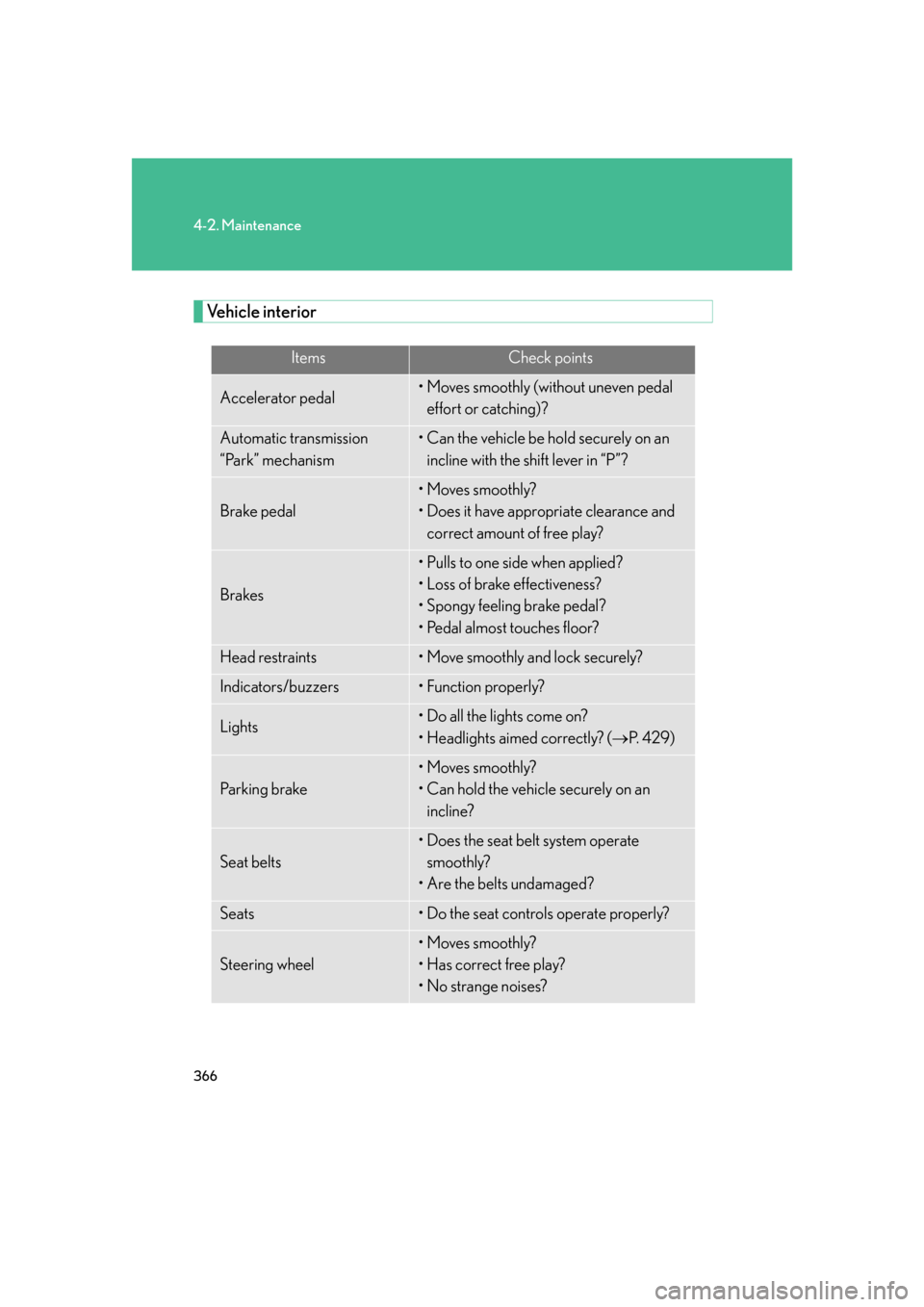
366
4-2. Maintenance
Vehicle interior
ItemsCheck points
Accelerator pedal• Moves smoothly (without uneven pedal effort or catching)?
Automatic transmission
“Park” mechanism• Can the vehicle be hold securely on an incline with the shift lever in “P”?
Brake pedal
• Moves smoothly?
• Does it have appropriate clearance and correct amount of free play?
Brakes
• Pulls to one side when applied?
• Loss of brake effectiveness?
• Spongy feeling brake pedal?
• Pedal almost touches floor?
Head restraints• Move smoothly and lock securely?
Indicators/buzzers• Function properly?
Lights• Do all the lights come on?
• Headlights aimed correctly? ( P. 4 2 9 )
Pa r k i n g b r a ke
• Moves smoothly?
• Can hold the vehicle securely on an
incline?
Seat belts
• Does the seat belt system operate smoothly?
• Are the belts undamaged?
Seats• Do the seat controls operate properly?
Steering wheel
• Moves smoothly?
• Has correct free play?
• No strange noises?
Page 406 of 562
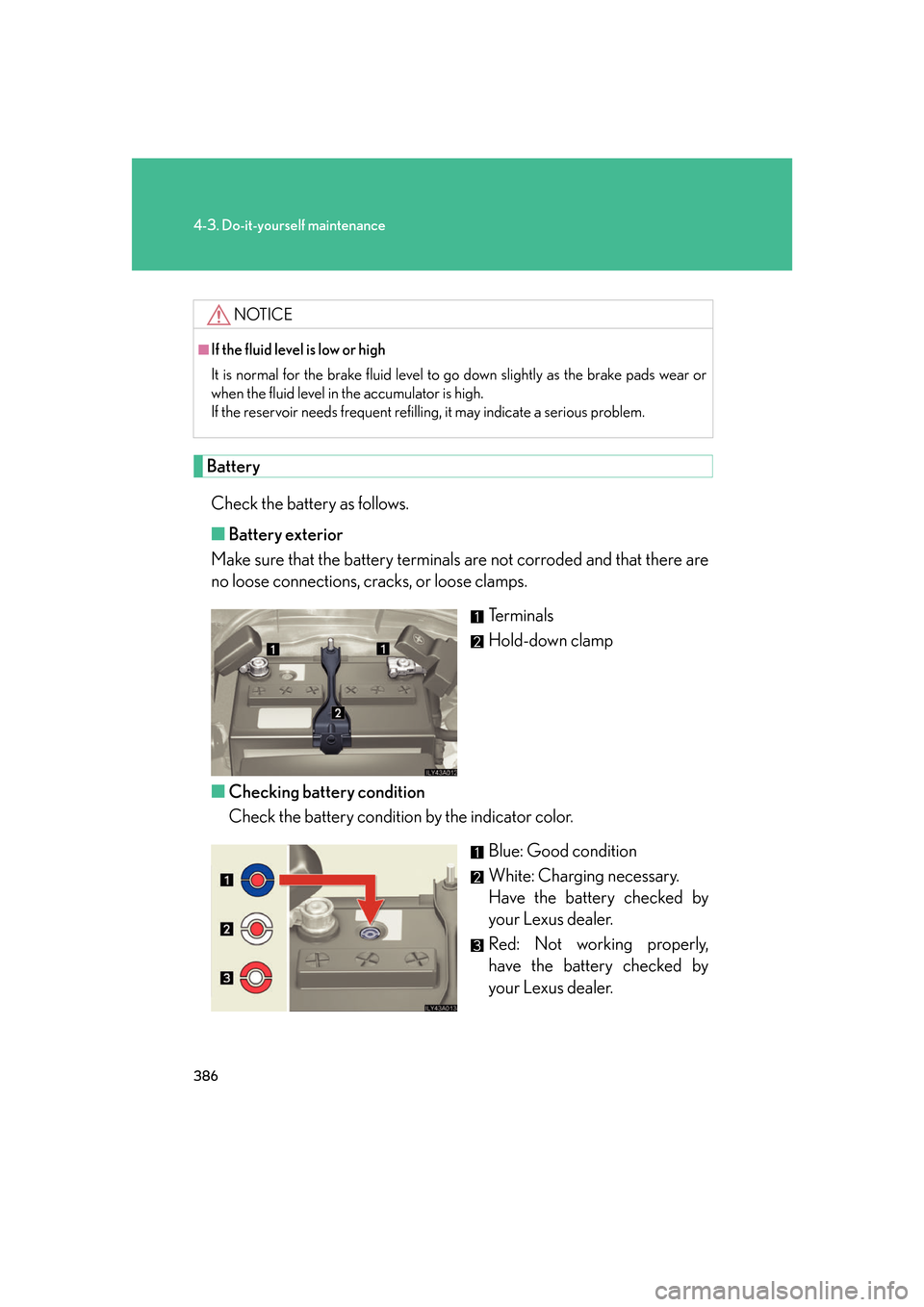
386
4-3. Do-it-yourself maintenance
Battery
Check the battery as follows.
■B
attery exterior
Make sure that the battery terminals ar e not corr
oded and that there are
no loose connections, cracks, or loose clamps.
Terminals
Hold-down clamp
■ Checking batter
y condition
Check the battery condition by the indicator color.
Blue: Good condition
White: Charging necessary.
Have the battery checked by
y
our Lexus dealer.
Red: Not working properly,
have the battery checked by
y
our Lexus dealer.
NOTICE
■If the fluid level is low or high
It is normal for the brake fluid level to go down slightly as the brake pads wear or
when the fluid level in the accumulator is high.
If the reservoir needs frequent refilli ng, it may indicate a serious problem.
Page 469 of 562
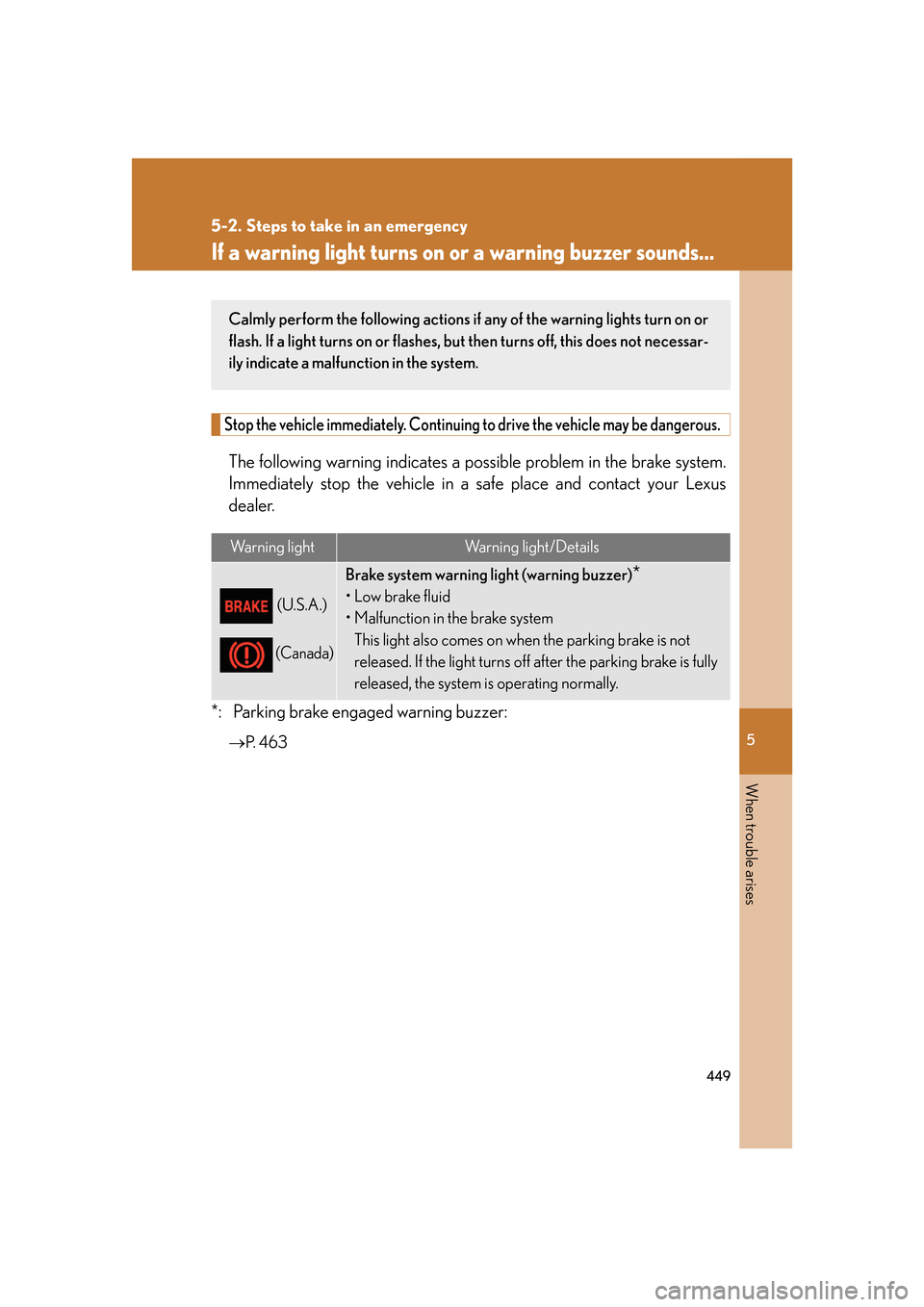
5
When trouble arises
449
5-2. Steps to take in an emergency
If a warning light turns on or a warning buzzer sounds...
Stop the vehicle immediately. Continuing to drive the vehicle may be dangerous.
The following warning indicates a possible problem in the brake system.
Immediately stop the vehicl e in a safe place and contact your Lexus
dealer.
*: Parking brake engaged warning buzzer:
P. 4 6 3
Warning lightWarning light/Details
(U.S.A.)
(Canada)
Brake system warning light (warning buzzer)*
•Low brake fluid
• Malfunction in the brake system
This light also comes on when the parking brake is not
released. If the light turns off after the parking brake is fully
released, the system is operating normally.
Calmly perform the following actions if any of the warning lights turn on or
flash. If a light turns on or flashes, bu t then turns off, this does not necessar
-
ily indicate a malfunction in the system.
Page 471 of 562
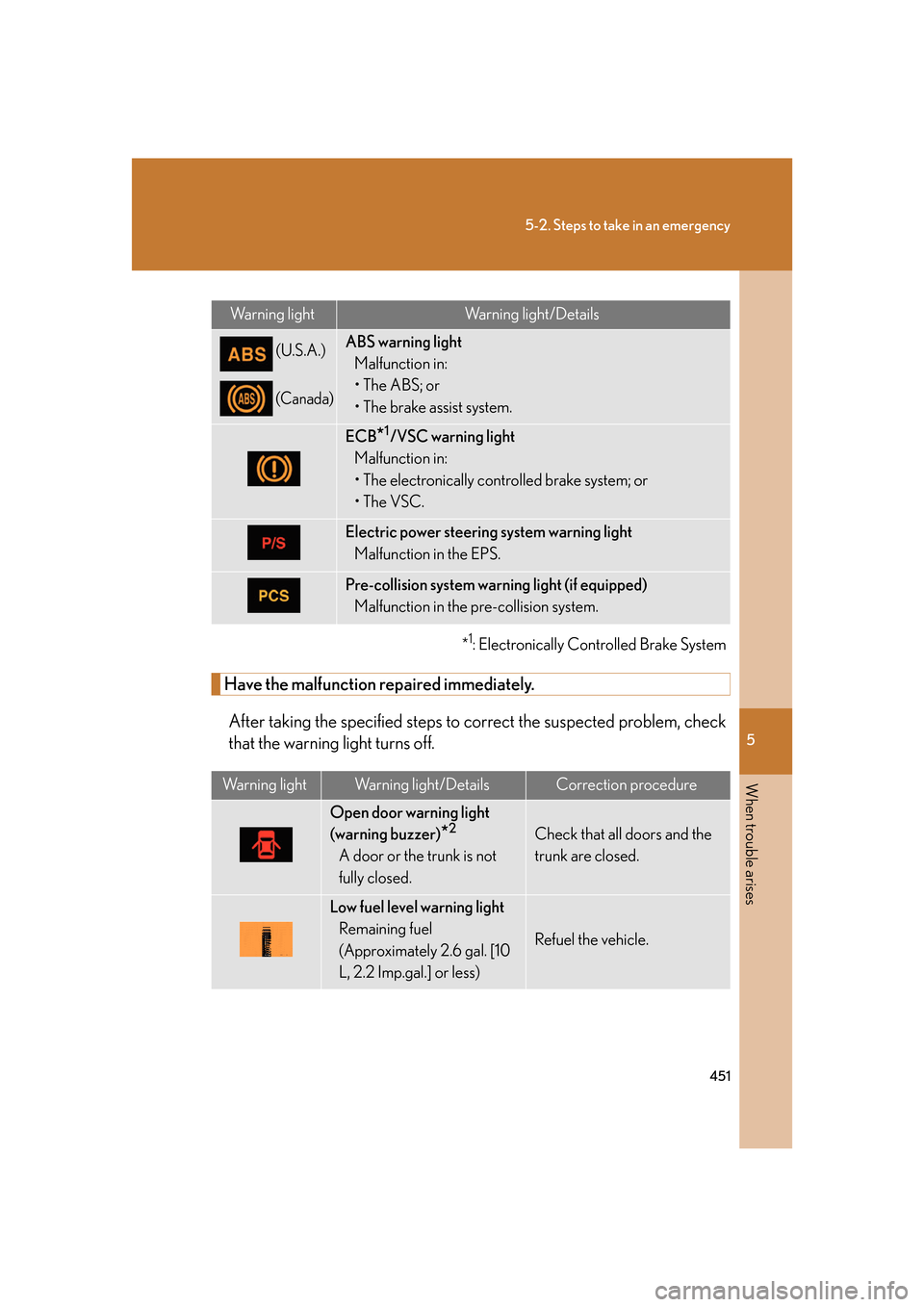
5
When trouble arises
451
5-2. Steps to take in an emergency
*1: Electronically Controlled Brake System
Have the malfunction repaired immediately.
After taking the specified steps to correct the suspected problem, check
that the warning light turns off.
Warning lightWarning light/Details
(U.S.A.)
(Canada)
ABS warning lightMalfunction in:
•The ABS; or
• The brake assist system.
ECB*1/VSC warning light
Malfunction in:
• The electronically controlled brake system; or
• The VSC.
Electric power steering system warning light Malfunction in the EPS.
Pre-collision system warning light (if equipped)Malfunction in the pre-collision system.
Warning lightWarning light/DetailsCorrection procedure
Open door warning light
(warning buzzer)
*2
A door or the trunk is not
fully closed.
Check that all doors and the
trunk are closed.
Low fuel level warning light
Remaining fuel
(Approximately 2.6 gal. [10
L, 2.2 Imp.gal.] or less)
Refuel the vehicle.
Page 474 of 562
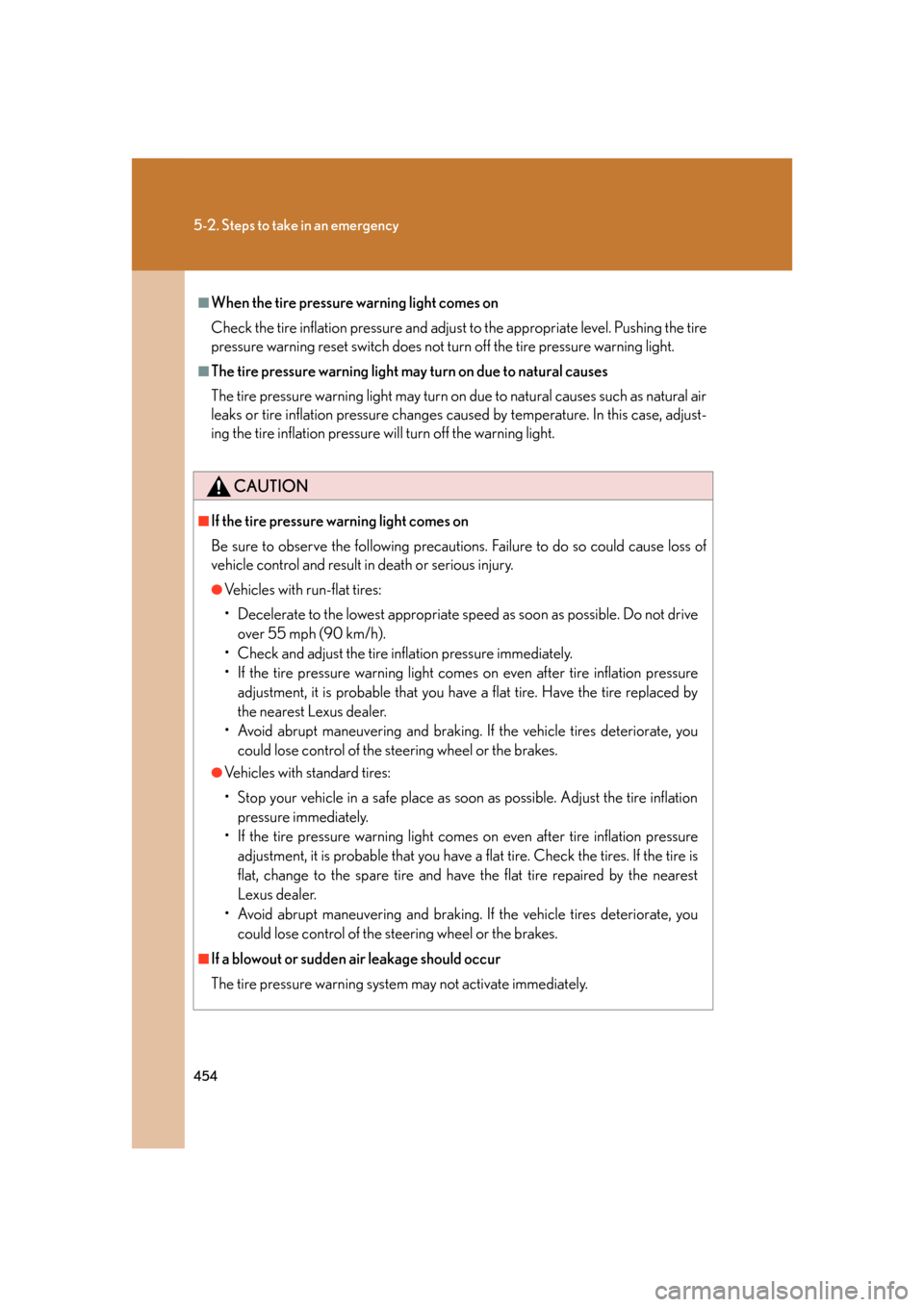
454
5-2. Steps to take in an emergency
■When the tire pressure warning light comes on
Check the tire inflation pressure and adjust to the appropriate level. Pushing the tire
pr
essure warning reset switch does not turn off the tire pressure warning light.
■The tire pressure warning light may turn on due to natural causes
The tire pressure warning light may turn on due to natural causes such as natural air
le
aks or tire inflation pressure changes caused by temperature. In this case, adjust -
ing the tire inflation pressure will turn off the warning light.
CAUTION
■If the tire pressure warning light comes on
Be sure to observe the following precautions. Failure to do so could cause loss of
vehicle control and result in death or serious injury.
●Vehicles with run-flat tires:
• Decelerate to the lowest appropriate speed as soon as possible. Do not drive
over 55 mph (90 km/h).
• Check and adjust the tire inflation pressure immediately.
• If the tire pressure warning light comes on even after tire inflation pressure adjustment, it is probable that you have a flat tire. Have the tire replaced by
the nearest Lexus dealer.
• Avoid abrupt maneuvering and braking. If the vehicle tires deteriorate, you
could lose control of the steering wheel or the brakes.
●Vehicles with standard tires:
• Stop your vehicle in a safe place as soon as possible. Adjust the tire inflation pressure immediately.
• If the tire pressure warning light comes on even after tire inflation pressure
adjustment, it is probable that you have a flat tire. Check the tires. If the tire is
flat, change to the spare tire and have the flat tire repaired by the nearest
Lexus dealer.
• Avoid abrupt maneuvering and braking. If the vehicle tires deteriorate, you
could lose control of the steering wheel or the brakes.
■If a blowout or sudden air leakage should occur
The tire pressure warning system may not activate immediately.
Page 552 of 562
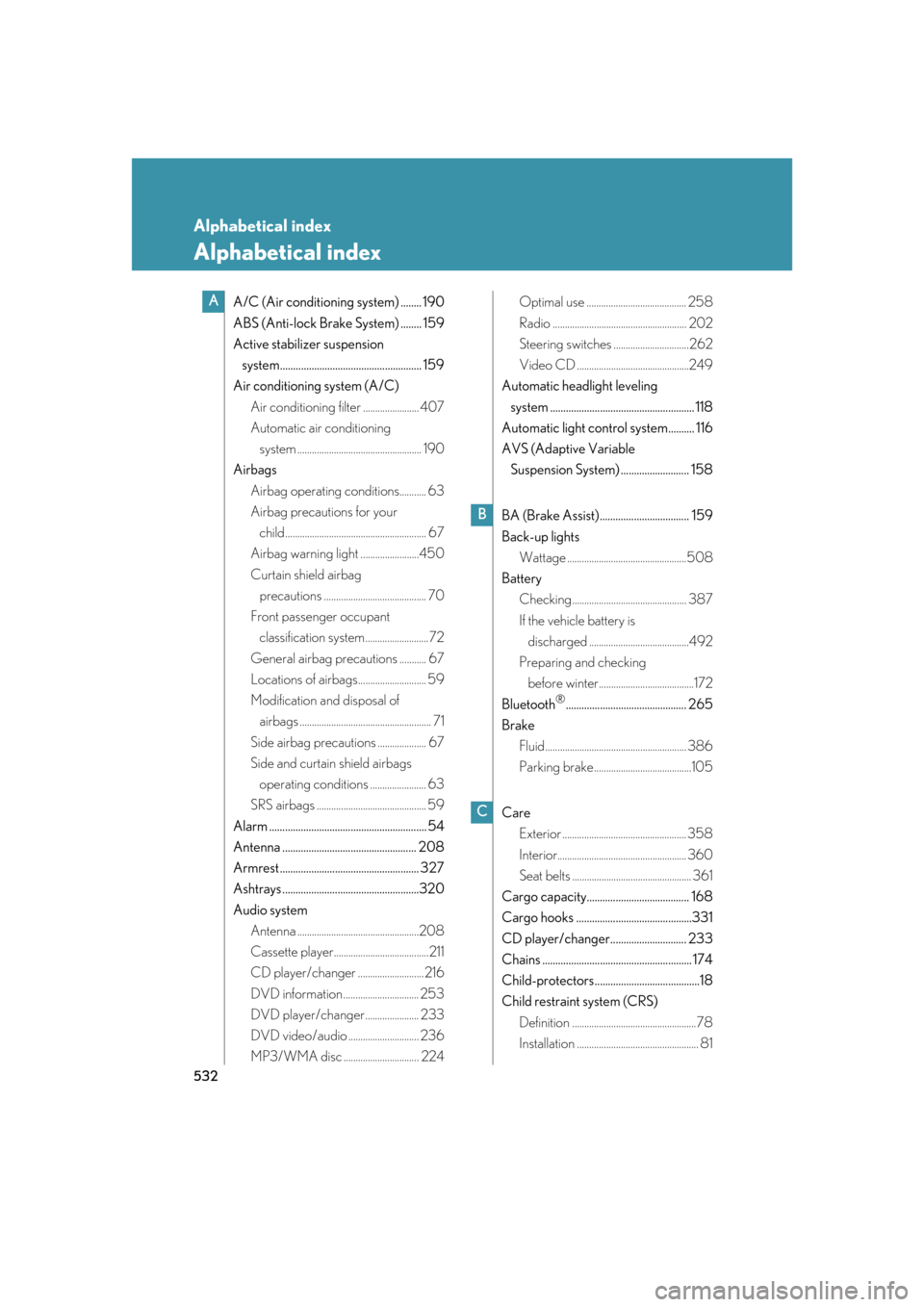
532
Alphabetical index
Alphabetical index
A/C (Air conditioning system) ........190
ABS (Anti-lock Brake System) ........ 159
Active stabilizer suspension
system...................................................... 159
Air conditioning system (A/C) Air conditioning filter ....................... 407
Automatic air conditioning
system ................................................... 190
Airbags Airbag operating conditions........... 63
Airbag precautions for your
child.......................................................... 67
Airbag warning light ........................ 450
Curtain shield airbag
precautions .......................................... 70
Front passenger occupant
classification system.......................... 72
General airbag precautions ........... 67
Locations of airbags............................ 59
Modification and disposal of
airbags ...................................................... 71
Side airbag precautions .................... 67
Side and curtain shield airbags
operating conditions ....................... 63
SRS airbags ............................................. 59
Alarm ............................................................ 54
Antenna ................................................... 208
Armrest ..................................................... 327
Ashtrays .................................................... 320
Audio system Antenna .................................................. 208
Cassette player....................................... 211
CD player/changer ........................... 216
DVD information ............................... 253
DVD player/changer...................... 233
DVD video/audio ............................. 236
MP3/WMA disc ............................... 224Optimal use .........................................
258
Radio ....................................................... 202
Steering switches ............................... 262
Video CD .............................................. 249
Automatic headlight leveling
system ....................................................... 118
Automatic light control system.......... 116
AVS (Adaptive Variable
Suspension System) .......................... 158
BA (Brake Assist).................................. 159
Back-up lights Wattage ................................................. 508
Battery Checking............................................... 387
If the vehicle battery is
discharged .........................................492
Preparing and checking
before winter.......................................172
Bluetooth
®..............................................265
Brake Fluid .......................................................... 386
Parking brake........................................ 105
Care Exterior ................................................... 358
Interior..................................................... 360
Seat belts ................................................. 361
Cargo capacity....................................... 168
Cargo hooks ............................................ 331
CD player/changer............................. 233
Chains ......................................................... 174
Child-protectors........................................ 18
Child restraint system (CRS)
Definition ................................................... 78
Installation .................................................. 81
A
B
C